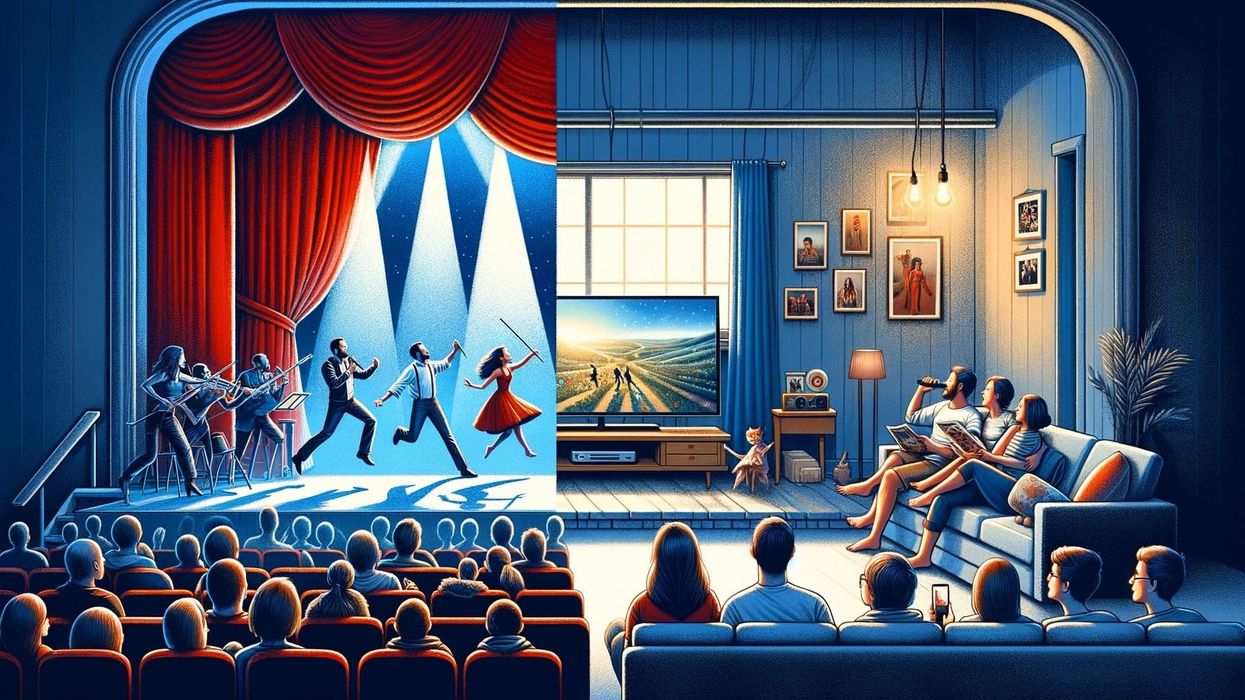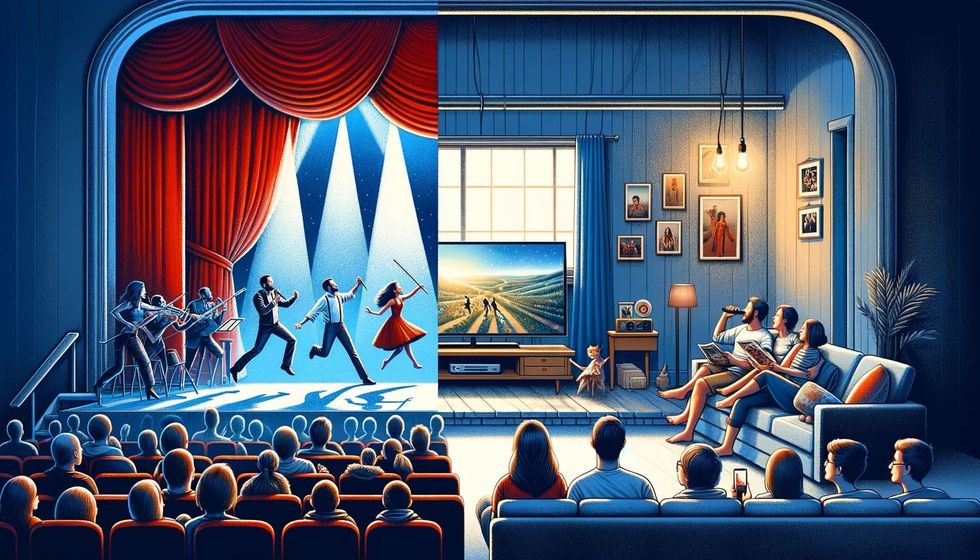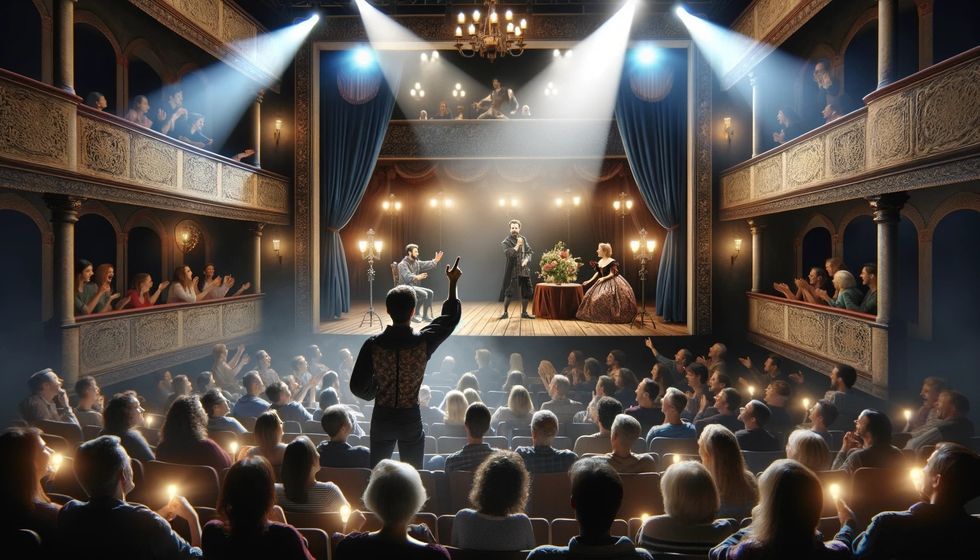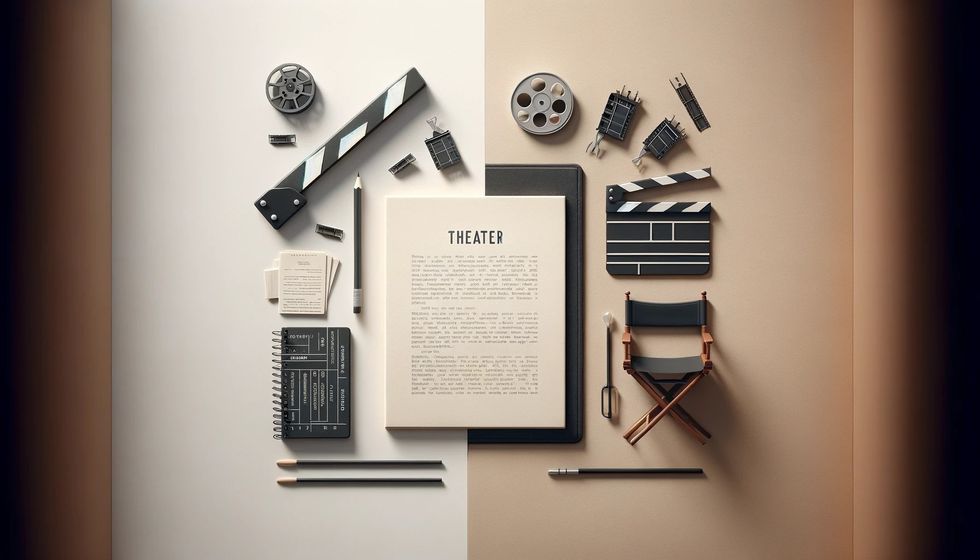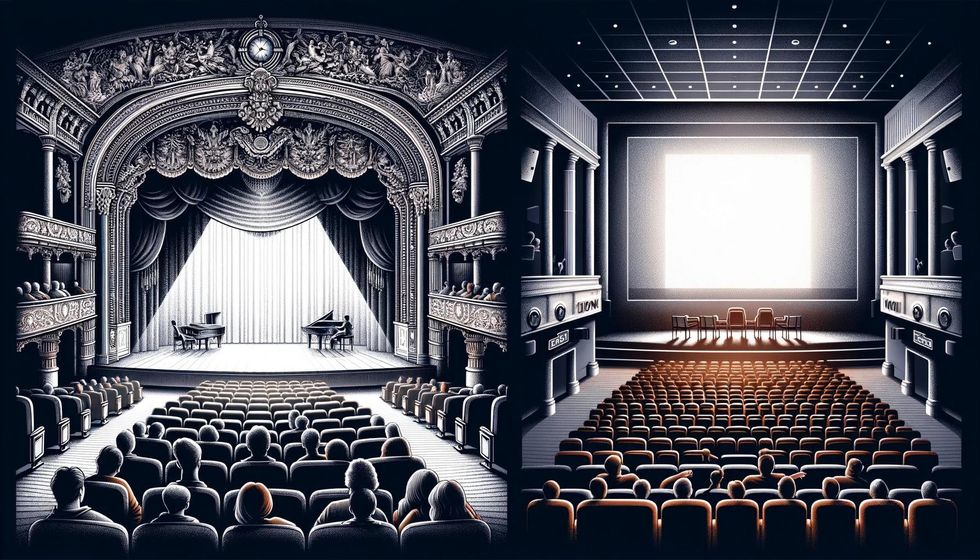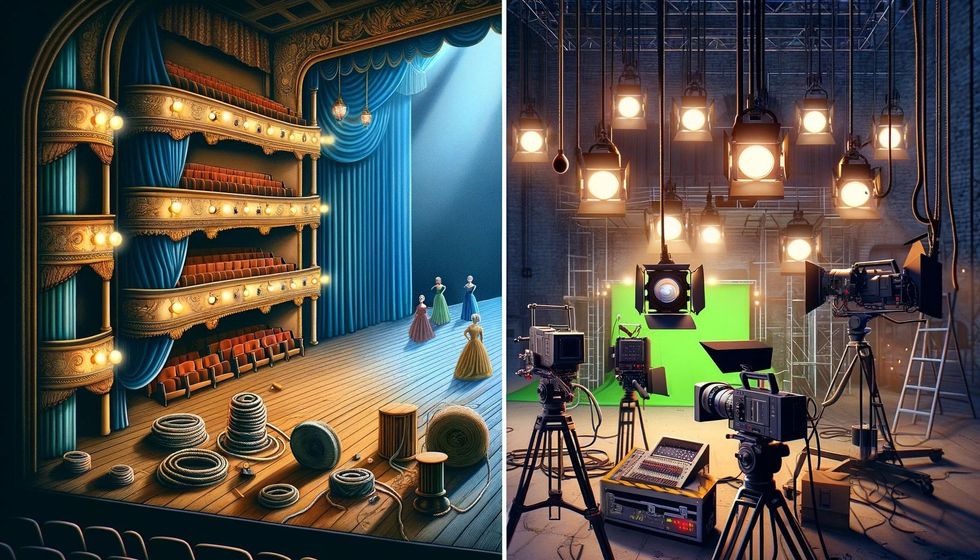Film and theater stand out as two art forms of storytelling, each rooted in its own history, techniques, and ways of engaging with audiences. While they share some similarities in acting and narrative delivery, the differences are as clear as comparing a traditional painting to a digital image.
Both are artistic mediums, yet captivating with their unique styles and approaches.
Theater has a rich history, tracing back to ancient Greek traditions, and is characterized by the live interaction between actors and the audience. Actors on stage share stories directly with viewers, making each performance one-of-a-kind.
The live nature of theater means that every reaction and gesture is shared in real time, creating a unique bond between performers and their audience.
Film offers a different storytelling approach, having captivated audiences for over a century. Films can transport viewers across time and space, making use of narratives that span days, years, or even centuries within a few hours. This is achieved through editing, which allows scenes shot at different times to be assembled into one story.
Film and theater are very different ways of telling stories, with each one having its customs and effects on the people who watch them. Both forms continue to excite and entertain, showing how human experiences can be felt and understood.
This article looks at the differences between theater and film, showing the different techniques often used, how they tell stories, and how they connect with people in their own special ways.
Performance And Audience Interaction Between Film And Theater

The way actors perform and connect with the audience is very different in film and theater. In theater, the actors and audience share the same space, allowing for direct interaction.
This makes live theater performances unique every time. On the other hand, film actors perform for the camera, and the audience watches the finished product. This section looks at these differences.
- In theater, actors perform live and need to make sure everyone in the room can see and hear them.
- Film actors work in front of a camera, which lets them use smaller gestures and facial expressions.
- Theater shows happen once, giving actors only one shot to get it right in front of an audience.
- A film actor, unlike a theater actor, can do the same scene many times to make it perfect.
- Theater has direct interaction with the audience, sometimes actors even talk to the audience.
- Film interaction with viewers happens through a screen, without live feedback.
- Theater plays are often known and have set expectations for how they should be done.
- Films offer new stories, so actors can be more creative without audience expectations.
- Theater needs actors to be loud and clear for all to hear and see.
- Films allow actors to act more like in real life because of the camera and editing.
Storytelling And Structure Between Film And Theater

The methods used to tell stories in film and theater have their own set of rules. Theater often follows a linear story in real-time, while films can jump around in time and place more freely. This part of the article explores how these storytelling methods affect the way stories are built and told.
- Theater stories usually unfold in order, happening right before the audience.
- Films can tell stories out of order, using flashbacks or jumping to different places.
- In theater, keeping the audience interested has to happen live, without cuts or edits.
- Films can change time and place to make the story more complex.
- Theater often uses a lot of talking and direct speech to tell the story because it's limited by the stage.
- Films use camera work and effects to add to the story, like close-ups or special scenes.
- Theater plays tend to stay in one spot or use very few places because it's live.
- Films can take you anywhere, from one side of the globe to another, making the story bigger.
- Theater relies heavily on words to show what characters are thinking or their history.
- Films can show characters' thoughts or pasts without needing them to say it out loud.
- In theater, everything has to work for a live show, thinking about how to change the scene or how long actors can perform.
- Films can control how fast or slow the story feels by how they edit the scenes together.
Audience Experience Between Film And Theater

Watching a play and watching a movie provide very different experiences. The environment, the sense of community, and the way the story feels can change a lot between a theater and a movie theater. This section discusses what makes the audience experience distinct in both settings.
- The theater creates a sense of togetherness, with everyone sharing the same moment and space, leading to a feeling of unity.
- Watching a film can be a shared activity, but it often feels more personal, with the main focus on the visual presentation.
- Live theater has a special feeling, knowing it's happening right then and there, making each performance unique.
- Watching a movie provides a consistent viewing experience, allowing fans to enjoy the same scenes and dialogues every time.
- Being in the same room with actors in a play often leads to a deeper emotional bond, as live emotions seem more intense.
- Films use camera techniques and music to shape how viewers feel, tailoring emotions to fit the scene perfectly.
- The design and atmosphere of a theater can make going to see a play feel like an event in itself.
- Modern movie theaters, with their high-quality sound and visuals, can fully pull viewers into the story's world.
- In theater, audience reactions can change the feel of a performance, making laughs and claps part of the show.
- While watching films, the audience's collective reactions can enrich the experience, though they don't change the film itself.
- Theater sometimes has breaks, like intermissions, where people can talk about the play and connect with others.
- Films generally play straight through, keeping viewers locked into the story from start to finish.
- Some theaters offer chances to meet the cast or talk about the play afterward, adding more depth to the experience.
- Film fans often continue their experience by talking about the movie online or waiting for extra scenes after the credits.
- Being physically close to the actors in a theater can make the performance feel more real and immediate.
- The use of film techniques can create scenes and effects that go beyond what's possible on stage, offering a visually unique experience.
Techniques And Technologies Used Between Film And Theater

The tools and methods used to create film and theater productions are not the same. Theater relies more on live performance and stagecraft, while film uses a variety of cameras, editing software, and special effects. Here, you'll look at how these techniques and technologies shape the final product.
- Theater uses live techniques like lighting, set design, and sound effects, often working within tighter limits than film.
- Films use many types of cameras to get shots from all sorts of angles, making the visual story more dynamic.
- Editing in film lets creators adjust the footage to make a polished movie with effects, color changes, and smooth transitions.
- Special effects in movies can include both real on-set tricks and computer-made visuals, creating scenes too complex for the stage.
- Theater's props and sets need to be cleverly made to look real within a smaller space.
- Computer graphics in movies can create whole new worlds and characters, adding magic to the story.
- Sound in theater has to match up with what's happening on stage, whether it's live or recorded ahead of time.
- Movie soundtracks are carefully made to fit the mood of each scene, with lots of detail added after filming.
- Theater costumes and makeup are bold, so everyone in the audience can see them, and they're made for quick changes.
- In movies, costumes and makeup can have fine details for close-up shots, aiming for realism.
- Theater relies on backstage teams for fast scene changes, needing perfect timing.
- Movies might use stunt doubles or experts for tough scenes to keep things safe and look real.
- Lighting in theater plays a big role in setting the tone, using creative solutions without film's technology.
- Movies can play with different camera lenses and lighting to create a special look or feeling.
- Everyone in a theater production practices a lot to make sure they get it right in one go, as live performances offer no do-overs.
- Film directors can do as many takes as needed and film scenes in any order, putting it all together later.
Preparation And Rehearsal Processes Between Film And Theater

Getting ready for a theater performance versus filming a movie involves different types of preparation and rehearsal. Actors in theater rehearse together to perfect their live performances, while film actors might focus on individual scenes, often out of sequence. This part examines the rehearsal and preparation processes for both mediums.
- Theater rehearsals are detailed and broken down into steps, helping actors fully understand their roles and the story.
- Film rehearsals might not happen as often and usually focus on where to stand and how to move with the camera in mind.
- The whole theater team works together during rehearsals, making decisions as a group.
- In film, the director often leads rehearsals, focusing on how actors will look on screen.
- Theater actors learn their lines and where to be on stage early on, making rehearsals more about interacting than memorizing.
- Film actors need to be ready for last-minute script changes, sometimes learning new lines right before shooting.
- Technical theater rehearsals bring together lights, sound, and scenery with the acting for the first time.
- Actors on film sets deal with technical stuff like cameras and lights all the time, not just in special rehearsals.
- Theater groups start in one place and move to the actual stage later, getting used to where they'll perform.
- Film actors have to adapt quickly to different filming locations, often without much time to prepare.
- Stage managers organize theater rehearsals, keeping everyone updated on what they need to do and when.
- Film directors might use rehearsal time to try out different ways of doing a scene, including improvisation.
- Theater rehearsals are a chance for a stage actor to try new things and find the best way to portray their characters.
- Rehearsals for movies sometimes focus on making sure actors work well together, particularly for scenes that need a lot of coordination.
FAQs
What is the main difference between stage acting and screen acting?
The main difference between stage acting and screen acting lies in the proximity of the audience and the use of the camera. In stage acting, actors perform live in front of an audience, often requiring exaggerated gestures and vocal projection to reach the back row and capture the audience's attention.
Screen acting, on the other hand, involves performing for a camera, allowing for more subtle facial expressions and naturalistic performances since the camera can capture every nuanced expression and bring the audience closer to the action.
How do preparation and rehearsal processes differ between theater productions and films?
Preparation and rehearsal processes for theater productions typically involve extensive group rehearsals over several weeks or months, focusing on developing a deep understanding of the character, memorizing all the scenes, and perfecting live performances.
In contrast, film actors might have shorter preparation times and focus on individual scenes, often rehearsing and filming scenes out of sequence. This requires screen actors to quickly adapt to different emotional states and story developments, sometimes with little notice.
Can actors easily transition between theater and film acting?
Transitioning between film and theater acting can be challenging due to the key differences in acting techniques, audience engagement, and the technical aspects of each medium.
However, many successful actors, have demonstrated that with practice and understanding of the distinct demands of stage and screen acting, actors can excel in both art forms. The ability to adapt from projecting to the back row of a theater to conveying emotions subtly on camera is crucial for actors looking to transition between the two art forms.
This article has explored the key differences between film and theater, covering how performances reach the audience, the ways stories are told, what the audience feels during the show, the tools and methods creators use, and how actors prepare.
Each section sheds light on the unique aspects that make film and theater distinct yet equally captivating ways of storytelling. Understanding these differences helps appreciate the art and effort behind each performance, whether it's on stage or on screen.
Related Articles Around the Web

